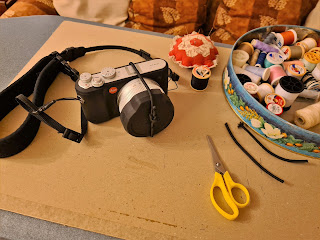I'm still at the British Museum, making a careful tour of the ancient-world exhibits. I'm really impressed by the sophistication of people living in the middle east four or five thousand years ago. These certainly weren't perfect societies, and from our point of view they were woefully lacking in the tech and healthcare departments. But their societies worked, and endured, and seemed reassuringly permanent - things we can't say of our own.
On the other hand, of course, they were conservative and resistant to change; they avoided surprises; and made no important voyages of discovery in case they strayed into forbidden or sacred parts beyond the horizon that might be the exclusive preserve of their gods. I don't think, for instance, that Ancient Egypt was aware of contemporary Chinese civilisation, nor would have made the effort to get in touch. Hemmed in by deserts and seas and superstition, they kept to their established territories, and fought savage local wars to hold onto what they had. It was never possible to take peace for granted.
It's the same today in that area. I rather think that the geographical facts of life in the middle east, and how those affected the constant jostling for good land, gold and influence, shaped the minds and policies of the ancients, and their descendants are the same today: saddled with attitudes built up over millennia, and too deep-rooted for any quick diplomatic fix brokered by outsiders.
So. I'm in a huge gallery on the ground floor of the Museum. I'm about to leave the Egyptian part behind and enter the fierce world of the Assyrians.
Immediately I notice a big difference. Gone are the serene sitting pharaohs, smooth-faced and calm. The Assyrians valued strength and the coercive power of fear. It is an aggressively masculine society, stern and bearded. Its imagery is designed to impress, and to convey an implacable threat of violence. Hence gateways featuring snarling lions with teeth and claws, and frighteningly powerful musculature.
The same sort of thing would be seen much, much later on the prows of Viking longships - all societies that have a use for intimidation resort to images that make weaker people despair.
The Assyrians often put a human head on these giant carved beasts. Heads with blank eyes and disdainful lips, with the wings of eagles added to a bull's or lion's body. More gateway frighteners:
Truly fearsome feet. But that was the intention, to instil awe and compliance, to cow foreign visitors and locals alike. Assyrian kings saw to it that, after each successful military campaign, all prisoners taken were cruelly mutilated. Or just butchered in public. All done to send a clear message to the conquered survivors. And indeed to anyone else in the region who had notions of defying the Assyrian empire in any way.
Sounds familiar? Where warfare is concerned, the lesson of history is that savagery gets results. It's about the only lesson aggressors take note of. They ignore the other lessons that tell them the party doesn't go on forever, and that all regimes burn themselves out sooner or later, usually faltering when the ruling family loses its grip, or fails to replicate itself. George Harrison was so right when he sang All Things Must Pass.
Here's an Assyrian king:
This king - I think it's an actual person, rather than the depiction of a god - has an unsmiling face, pitiless eyes, and holds a flail to lash his opponents with. He also has two murderous daggers tucked in his waistband. On his arms, metal bands that he probably couldn't remove. (That device on his left wrist looks like a watch, doesn't it? But of course it isn't) The sculptor has emphasised his arm muscles. This is a physically strong king you really don't want to mess with.
I'd had enough of Assyria. I wanted to see something less searing, less born of the hot desert. So I started to make my way to the Ancient Greek section. On the way, I saw something that wasn't Egyptian, but nor was it like the Assyrian exhibits. It was a clay tablet, not very large, showing - in high relief - a woman with wings and bird's feet. The Museum called her The Queen of the Night. She was in the company of owls.
Dating from about 1,775 BC, she predated the Assyrian empire. Although clearly a goddess (as she held the godly rod-and-ring in both hands), it seemed that nobody knew who she was meant to be. Her sensual nudity suggested Ishtar, the goddess of love and war; but there were reasons to prefer Ishtar's sister, Ereshkigal, who ruled the Underworld. There was a legend that Ishtar went to see her sister, and rather unwisely surrendered her clothes and protective possessions item by item as she penetrated deeper into Ereshkigal's domain, until she was naked and at her sister's mercy. (They weren't friendly) So this could be Ereshkigal, holding both her own and her sister's rod-and-ring symbols. Well, maybe.
It was thought that originally this tablet would be part of a shrine to whichever goddess it is. Being made of clay, and not of some precious metal, it was considered of no value when the shrine was later plundered or fell into decay, and so The Queen of Night survived, broken into three pieces, but largely intact. At some point in modern times she was found, and offered to the big museums. But there was a problem with her provenance. Where was she found? Who by? In what archaeological context? All these were unknown. And there were stylistic issues. Essentially she was a one-off with very little to compare her with. Was she a faked-up pastiche or the real thing? The museums turned her down. She ended up in the hands of a dealer. Then the British Museum had a change of heart and bought her. Her great antiquity has since been proved, but her identity remains an open question. The Museum currently favours Ereshkigal.
Close analysis has shown that originally she was painted red, picked out with gold, against a black background. So (according to Wikipedia) she could have looked a bit like this:
Although I like it, this may be rather too lurid. The WorldHistory website has a more toned-down version, perhaps too brown:
Pretty striking, all the same. The bird's feet and talons echo the owls', except that the talons are extra-vicious. They look rather odd in combination with her very female human body, but if this was in fact the Babylonian goddess of love and war, you'd expect some indication that she could be sharp and wounding as well as soft and yielding.
Well, I was impressed. Considering the second-class status of Babylonian women - contemporary laws meted out harsh treatment to erring women, and clearly they were little more than pawns in a power game conducted by men - here is a lady to respect!
Perhaps women especially venerated her, and would ask her to avenge the wrongs and hurts done to them by the cruel men in control of their lives. They'd wish her to appear before the man they hated, fiery red - and naked to tempt him - but with talons out, ready to tear and rend, and to teach that man a lesson. Come to think of it, I wouldn't mind invoking her - or being her - for an hour or two, just to wreak a similar revenge upon a small number of men (and one or two women, come to that) who messed me up in the past. What a wheeze that would be! Suddenly popping up, and giving them the fright of their lives.
[Enter an Arrogant Person, once Lucy's oppressor. Lucy now appears before them as an avenging goddess]
Lucy: I am The Queen of the Night. You have wronged me and offended me. Make yourself ready for death.
Arrogant Person: No! No! No! I will do anything you ask!
Lucy [Spreading her wings, flexing her talons, and looking redder than ever]: It is too late. I accept no appeal, nor any apology. Now you must die. I consign you to the Underworld forever.
Would I really do it? No, of course not.
Well, not much! I think it would be quite enough to give them a heart-stopping moment. Then let them reflect on their misdeeds, while I flapped off with my owls.
Tired of vengeful ways of thinking, I entered the Greek galleries with a deep sense of relief. The Greeks had their gods too, but somehow they all had a very human aspect. Fickle, capricious and occasionally jealous they might be, they were nevertheless only larger-than-life versions of ordinary people, and you could know them and relate to them. And their portrayal was through ordinary human bodies, albeit every one a superb physical specimen. No strange frightening beasts with demonic wings and claws here. All right, I admit there were graceful horses with wings; and creatures called centaurs that were half horse, half man; and woodland nymphs and satyrs; and Greek mythology had serpents galore, and ladies with snakes for hair, and one-eyed giants, and multi-headed dogs. And any lusty swan or ram could be Zeus himself. But hey, nothing too abnormal.
And the sculpture - compared to the stiff and static Egyptian and Assyrian output - was fluid and realistic and almost alive.
This was an ante-chamber. Through that distant door was a vast room containing the friezes taken from the Parthenon - the so-called 'Elgin Marbles'. Small risk of catching Covid there, I thought.
I have to say that, although magnificent, a lot of the carvings were somewhat weather-worn. I did wonder why we were still hanging onto them. Would it really do our national culture harm if we returned them to Greece, and just kept 3D-prints as faithful copies? Here's a selection anyway:
It was admirable how well the Greek sculptors had put lifelike movement into torsos and limbs and swirling clothing. All the carvings, whether human, half-human or all-animal, seemed to be in motion. Or only temporarily at rest, poised for fresh movement.
No wonder the Renaissance sculptors were so inspired by Greek models.
There was a story about centaurs being invited to a Lapith wedding-party. The Lapiths came from the Greek region called Thessaly: they were experts with horses. Centaurs and Lapiths shared a common human ancestry, but centaurs were new, the result of a Lapith man mating with mares, and were half man, half horse, with their human side only just more dominant than their wild-horse side. Anyway, centaurs never usually drank wine, and, when given some at this wedding-party, they got tipsy and their lustful and unruly horsy side took over. The Lapiths had to fight them to regain control, with some deaths ensuing. The centaurs were banished from Thessaly. Although easily defeated on that first occasion, in subsequent encounters things did not go so well for the Lapiths. I was struck by a group of stone panels that showed a centaur and a Lapith warrior wrestling, with the centaur mostly getting the upper hand.




Extraordinary artistic skill. In my Flickr album for 'British Museum' I include the captions which explain the carvings in full.
It was time to go. I had a long walk ahead of me, back to London Victoria station, and I wanted to go via Theatre-land, the Victoria Embankment, Big Ben and Westminster Abbey. The next post in this series.

























































